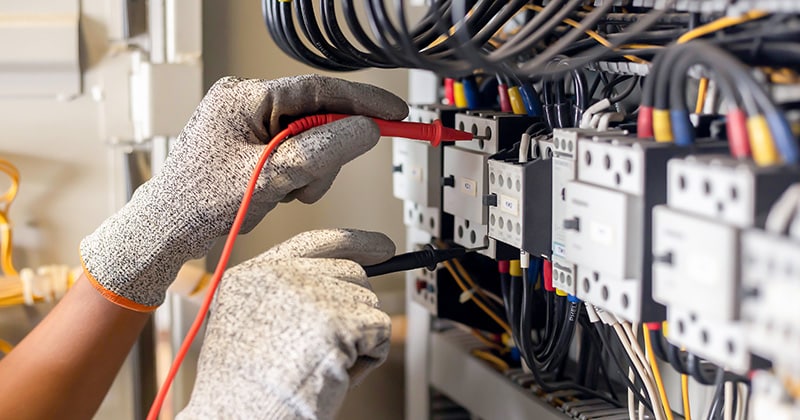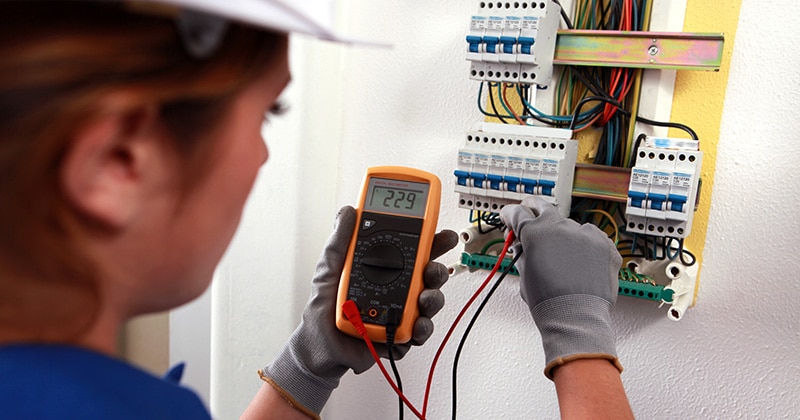How to Reduce Late Payments for Contractors
Online payments for electricians aren’t the wave of the future anymore—they’re here now. Learn how replacing old-fashioned payment methods can save you time, money, and stress.
You’ll also make business transactions easier for customers with the switch. Read on to learn about the benefits of online payment systems. Get tips on how to get started, including how to introduce new methods to customers.

Importance of Efficient Payment Systems for Electricians
When you have your own business, you can’t count on a paycheck from a corporate accounting department. So you need to figure out a payment system for yourself that’s reliable, efficient, and timely.
The Downsides of Inefficient Payments
Without streamlined payments, you could run into one of these problems:
- Falling short to pay yourself or your own staff on payday
- Using savings to cover everyday expenses
- Running up your credit cards and damaging your score
- Spending too much time chasing money
When you have to invest too many hours hunting down payments, that cuts into the billable hours you have available. That, in turn, reduces your revenue. Decreased or unpredictable revenue is time-consuming and stressful for all contracting businesses.
If you go too long without getting paid for bigger jobs, it can pose a serious threat to your livelihood. You could reach a point where you can’t pay your insurance or other operating expenses. That could force you out of business permanently.
Challenges Electricians Face Collecting Payments
Electricians and other contractors often run into the same hurdles when trying to get paid for their work.
One of the most common is a lack of staff to handle accounting. You likely have a handful of people on your crew, and they all work in the field. It comes down to you to handle billing.
It can be even worse if your team splits up over different jobsites. You have to rely on your workers to deliver invoices when a project is complete. And you may not know if they’re giving the right message to the client about timely payment or perhaps collecting a check on the spot.
Another issue for electricians is they may function as subcontractors for a general contractor or home builder. This means you have to get the general contractor to pay you, which often means they need to get paid first by the client. It can result in delays and wasted time inquiring about payments.
Many businesses submit invoices in advance of providing services. But electricians don’t usually have this luxury. You have to wait until you complete a job, in case your final bill is more or less than the original estimate.
It’s possible you’ll run into complications that involve more labor or parts than you previously thought. The client may approve the extra expense, but you still can’t bill in advance.
Finally, there is the issue of the method of payment. If you’re like lots of small contracting businesses, you get paid in different ways. Some business clients may cut you a check, although fewer people are using checks at all nowadays.
Others prefer bank transfers. These days, electricians use everything from PayPal to Zelle to Venmo to get paid. This is especially true if they work primarily on smaller jobs for homeowners who don’t have a corporate checkbook.
All these different methods, plus the other challenges mentioned above, add up to headaches for you. You never know when the money is coming in, even once a client has paid, because each system uses a different schedule.
That’s why many electrical contractors are shifting to online payments today. As you’ll read below, it smooths the payment process, giving you more reliability. And it’s better for customers too.

Benefits of Implementing Online Payment Systems
There are many advantages to adding an online payment method to your electrical contracting business. Let’s look at some of the major ones in a little detail.
Fewer Late Payments
How do you handle invoicing right now? Do you email or snail mail a bill after every job? Do you hand the customer an invoice without a clear payment deadline? That contributes to late payments and financial uncertainty.
However, with an online payment system, you typically have a couple of options:
- Credit or debit payment on the spot using a terminal or card reader that attaches to your mobile phone
- Electronic payment on your website using the client’s credit card, debit card, or bank account
With the first option, you get paid right away or within about 24 hours. With the second option, there’s no “check’s in the mail” excuses or waiting for a physical check to clear.
Increased Efficiency
As you might imagine, taking online payments is quicker and smoother than using old-fashioned pen and paper. This gets you onto your next job faster, so you can make more money.
Also, everything is online. You don’t have to worry about lost receipts and files of paperwork when it comes to paying taxes or performing business audits.
Cost Savings
With that increase in efficiency comes cost savings. You’re not wasting time, as mentioned above, chasing your earnings. And if you’ve been thinking about hiring someone to handle billing, you might not need anyone with an online payment system.
Flexibility When You Need It
Most online payment platforms give you some flexible options if necessary. For instance, you can change the billing date for a time in the future if that works for you and the client. Or you might even be able to offer financing for larger projects, with payments split over time with interest to make up for the delay in payment.
RELATED ARTICLE: How to Offer Financing as a Home Services Contractor
Convenience
You’ll find many clients like the ease of online payments. They don’t have to be concerned with mailing a check.
Keeping customers happy has two key benefits:
- They’re more likely to return for other jobs in the future.
- Satisfied customers give positive online reviews and personal recommendations.
Customer retention and free word-of-mouth advertising are worth their weight in gold. Repeat business and new clients are the two cornerstones of a stable business that might also see opportunities for growth.
Improved Client Security
Another thing that keeps customers happy with online payments is the increase in security it provides. Using old-school accounting methods makes personal and financial information much more vulnerable. This can lead to identity theft or money crimes if you have an unscrupulous employee or if your office was robbed.
Online payment methods offer layers of security that you can’t get with paper systems. Each platform works a little differently, but they all offer secure data and information transfer for your peace of mind.
Fewer Errors
With the more automated approach of online payments, you reduce errors too. No more writing down credit card numbers by hand to run back at the office. Say goodbye to math errors when adding up revenue at the end of the month or quarter.
Easier Reporting for Your Business
When it’s time to generate reports for your company, online payment systems make this much simpler. You can pull data for tax returns, audits, or forecasts you need to scale the business.
FROM ONE OF OUR PARTNERS: How to Grow and Run a Successful Electrical Business

Key Features of Online Payment Platforms
As we said above, every payment platform operates a little differently. That said, here are some of the top features you can expect to find in many systems:
- Customizable invoice generation for different jobs
- Multiple payment options for different card/account types
- Alternative payment choices, like digital wallets (37% of online payments)
- Encrypted transactions and secure payment gateways
- Customer authentication and fraud prevention
- Quick settlement, either instant or within 24 hours
- In-person, on-the-go, or online payment options
- Ability to take recurring payments from the same client
- Options for refunds and discounted payments
- Strip, chip, and contactless payment capability
- Integration with existing business software
- Dashboard for managing multiple payment terminals
- Scalability to adjust as the contracting business grows
- The ability to have customers cover transaction fees
You know the unique needs of your business. Make a checklist of the most important features to you. Then research online payment platforms that tick those boxes.
While you, of course, want a system that’s best for your company, think of your clients too. Globally, 20% of consumers have been victims of payment fraud, so you want to reduce that risk whenever possible.
FROM ONE OF OUR PARTNERS: The Most Popular Mobile Payment Methods for Business Owners
Strategies for Maximizing Customer Engagement
You want to make sure that implementing mobile or online payments helps and not hinders your customer rapport. Here are some ideas for how to make the most of your new payment system with your clients:
- We mentioned flexible payment options above. Offering financing on big-ticket items, like home rewiring, is one key example.
- If allowing a customer to split up payments, use an auto-pay system. Then neither you nor the customer will have to think about it when it’s time for the next installment.
- Consider creating a customer portal on your website if you have recurring clients or customers who want to pay from a bank account. There, they can access invoices, payment history, and other important information.
- Link your payment system to the software you use for estimates and quotes. This will make everything more streamlined for both your company and the client.
- Before switching to an online payment process, be sure to let customers know. You can use a website banner, mass email, newsletter, etc., to inform them. Once the new system is in place, always notify the customer when scheduling a job. Tell them that payment is expected on the spot, unless other arrangements have been made.
FROM ONE OF OUR PARTNERS: The 6 Best Small Business Payment Options
6 Tips for Electricians to Simplify Workflows With Online Payments
Are you ready to get started with an online payment system soon? Here are some final suggestions to make it go smoothly for your business:
- Choose a system with a low learning curve for implementation. Do make sure to train workers, though, so they know how it works.
- Understand what kind of financial commitment is involved. Most platforms charge a fee. How is the fee calculated? Do you have to sign a contract for a certain period of time?
- Look for platforms that offer demos or free trial periods. You’ll have a better idea of how the system works when you can see it live.
- Are you just starting your business? Don’t have the credit score you want yet? Look for platforms that make it easy for anyone to obtain a merchant account.
- Many platforms include card readers. This makes life easier, but find out what that entails. Is there an extra fee? What if a reader is damaged—are you responsible?
- Implementing online payments is the perfect time to think about upgrading the technology for the rest of your business. If you’re not yet using electrical contractor management software, you could start. Setting it all up together means you can customize everything once at the same time.